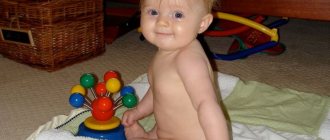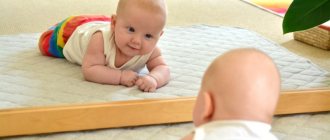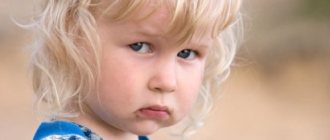Many mothers are interested in when a child begins to coo, whether this process can be accelerated, and what to do if the baby refuses to make contact. If all children start talking at different times, then they go out at about the same time. This is explained by the peculiarities of the formation of the speech apparatus, the type of children’s perception of the world around them.
Despite the fact that very young children do not yet have a clear understanding of the importance of their mother or father, they feel the connection on a subconscious level, and it gradually strengthens during tactile communication. The baby hears the voices of his parents and it is they who become his first reference point in the field of sounds. After some time, the child begins to master a new type of communication.
The baby stopped
One of the brightest and most long-awaited events for parents is the first independent sounds uttered by the child.
Joyful sensations are often accompanied by worries, because children's croaking can stop as quickly and unexpectedly as it appeared. There may be several reasons for this kind of boycott. If a child stops gurgling at 4 months, this event should not be ignored.
In most cases, this is the norm in speech development, but sometimes silence is a sign of physiological and emotional abnormalities.
The ability to coo - about the importance of the skill in the development of a child
Speech develops from simple to complex. Cooing is one of the types of speech activity that children master at 3–4 months.
The first training in sound production occurs voluntarily. At 2–3 months, this process is poorly developed and the baby can only pronounce vowels. This becomes a favorite pastime; no conscious control of sound chains is observed at this age.
Active, conscious and emotionally charged cooing is noted at 4 months of age. Sounds become a way to communicate with adults and favorite toys. During this period, the ability to control the muscles of the palate is formed. The baby masters the first consonants “g” and “x”, and in combination with vowels, the traditional and long-awaited “Agu” for parents is built.
The set of pronounced sounds is always individual and there can be any number of combinations. Don't worry if your baby's babbling is not similar to his usual cooing, and he makes fewer sounds than his peers. Enjoy another small victory and be attentive to any changes during this period.
The child does not coo at 4 months - is it worth worrying about?
Children in a good mood coo frequently and very emotionally. At four months they are already actively moving and laughing loudly.
When the diapers are dry, the baby is fed, healthy, and his mother is nearby, he communicates with pleasure in the language of sounds familiar to him.
The reason for this sudden silence may be psychological problems. Children also experience stress. Any negativity in the family affects speech development. Lack of attention can provoke silence. If parents are always busy and spend little time with their child, he may respond with silence. There are also physiological factors:
- Immaturity of the speech apparatus.
- Hearing problems.
- Underdevelopment of facial muscles.
- Neurological disorders.
- Consequences of past illnesses.
To rule out the possibility of abnormalities and put your mind at ease, visit your pediatrician. Specialists will help identify and promptly eliminate health problems.
There are often cases when a child does not coo at 4 months and does not even try to pronounce new sounds. This behavior should also be cause for concern. As for the unusual and unexpected silence of the baby for the parents, according to pediatricians, such a change is considered one of the normal variants.
This is just a preparatory stage for mastering new speech skills. Children always do what they like and enjoy. At some point, they get bored just yapping.
They pay attention, listen to what their parents say, absorb information, facial expressions and movements. They simply have no time to be distracted by cooing in the process of detailed study of the surrounding people and space
conclusions
The first sounds are the predecessors of words. The ability to coo is considered one of the important and necessary stages in pre-speech development. Don’t worry if your child takes a break and at 4 months stops pronouncing the sounds you are familiar with and already love. Time will pass and he will return to cooing, but it will be a more interesting and richer assortment of children's sounds and emotions.
From the author
I am glad that you read this article to the end. I can assume that you liked it, and the absence of advertising, which constantly distracts you from reading, created comfortable conditions for your pastime on my channel.
Put “Like” if the article satisfied your interest or put “Dislike” if you were not interested in reading at all. Your ratings will help me write more interesting material.
I will be grateful if you subscribe to my channel .
I promise to please you only with high-quality content!
What to do if your baby stops gurgling
At 4 months, babies walk using palatal sounds in their speech. Many parents begin to worry in a situation where an actively talking baby suddenly stops doing so. At 3 and 4 months, this can indicate both the norm and the presence of a problem. Many babies stop making noise in preparation for pronouncing new letters. Stress or illness experienced by the child can lead to a situation of refusal to speak.
When does a child start laughing?
Loud, sincere children's laughter is an incredibly pleasant sound, especially if you hear it from your child! It seems that your baby was born just recently and began to look at everything around with surprised eyes.
Mom's affectionate touches caused his first smile and cooing... And now you are looking forward to when the child begins to laugh out loud, and not just make joyful sounds.
We will tell you in this article how a baby’s emotionality develops, and whether you should worry if the baby is not laughing yet, although it seems like it’s time.
When does a child start laughing out loud?
A newborn baby sleeps almost all the time during the first month of his life - this is how he adapts to life outside the mother's womb.
At about a month old, he becomes more sociable and begins to show interest in the world around him. The little explorer's first manifestation of joy is a smile, usually addressed to his beloved mother.
Later, in combination with the voice, some semblance of laughter is created (joyful hooting, hooting, hooting).
So, as we see, the question: “When should a child laugh?” - somewhat incorrect. All children are very different emotionally and can start laughing at different times.
The child does not laugh out loud
Is it worth worrying if the baby doesn’t laugh, unlike his peers who are laughing with all their might? It often happens that a mother worries: “A child at 4 months (5 months) is not laughing! Why? Everyone I know has children bursting into laughter from the age of 2-3 months...”
First of all, in this case, you need to remember that comparing a child with his peers is a thankless task. And in the case of laughter, it’s also meaningless. First, the “skill” of laughter itself is not diagnostic of normal child development.
And secondly, laughter is influenced not so much by the baby’s intelligence or your attention to him, but by the temperament and habits of expressing emotions in the family. https://www.youtube.com/embed/vA0Ip1wnCu8
Why doesn't the child laugh? First of all, this may be due to the immaturity of the nervous system. After all, some mothers begin to worry when their babies are only two or three months old. In this case, you just need to wait.
The next reason is the lack of manifestation of joyful emotions expressed by mom and dad, restraint and excessive self-control of adults. A very young child laughs, often seeing and hearing his parents laugh.
In addition, we must not forget that some babies are simply serious and thorough, one might say, from birth.
How to teach a child to laugh?
Children are amazing creatures who truly know how to rejoice and enjoy life. For kids, everything around is new and surprising; they learn about the world through play. In addition, the body of a baby produces much more of the pleasure hormone endorphin than an adult. Therefore, in general, there is no need to come up with something supernatural to teach a child to laugh on purpose.
First of all, pay attention to how often you smile and laugh yourself, and how generally this is accepted in your family. Children in the first months of life, like a sponge, absorb everything they see and hear around them.
What do children laugh at? Anything can make them laugh. Some people are very amused by the massage that their mother gives them; others laugh at how dad blows on their tummy; Many children are surprised and happy when they hear unusual sounds or unusual-sounding words.
Some babies may even be scared at first when they hear themselves laugh. But after a while, realizing that they themselves are the source of this unusual sound, they begin to laugh with or without reason (as it may seem from the outside). In fact, such laughter for no reason is a pleasant and useful training for a baby in a new skill.
We hope that the baby will soon delight you with a happy, roaring laugh. This is one of the most pleasant sounds for a loving mother - so let it sound in your home as often as possible!
Source
How to determine that your baby hears and understands you, but is silent
Babies often show no desire to communicate when they are feeling unwell. Lack of attention to the actions carried out by adults may be due to the fact that the baby is tired. It is possible to understand whether you have problems with hearing and concentration by conducting a simple test.
During normal development, the following reactions should be observed:
- at sharp sounds the baby shudders;
- a month-old baby turns his head towards the sound source, which is behind him;
- a four-month-old child reacts by moving his head towards a toy that sounds near him.
The baby, when communicating with an adult after the start of the party, actively helps himself by moving his legs and arms. When communicating with an adult, he expresses a complex of animation; emotions can cause squealing and laughter.
Key milestones in language development before one year of age
Organs and muscles important from the point of view of speech development (lips, tongue, hearing) are usually developed in children from birth. However, in the first 4 weeks of life, newborns only cry. They exhibit and develop different types of crying.
Cries from hunger, pain or fatigue are usually different. The same letters pronounced in different intonations can speak of protest, discontent, and childish admiration. The pronunciation volume for each intonation is also different.
Booming and cooing in infants are precursors to speech development. This is an important stage in the baby’s speech development; the child experiments with the pronunciation of articulated sounds, but does not yet pronounce clear, recognizable words.
2 months
The second month of life brings a long-awaited smile. At about 1–2 months, the baby not only screams, but also “sings” - makes the sounds “aaa-guu”, “a-gyy”, “g-yy” and others. The child gurgles and gurgles against a background of positive emotions, physical activity, and is in high spirits. The humming and the accompanying “revival complex” are interconnected. The child can also spontaneously and continuously “chat” in a calm state, lying in his crib.
A baby at the age of 2–3 months can already recognize his mother’s behavior and associate his humming with it. Understanding that the mother enjoys the sound she makes is an incentive to continue communicating with others. Therefore, many children, in response to speech addressed to them, begin to babble more intensely.
3 months
The development of a baby in the third month of life is not only about the pronunciation of sounds. Hearing, smell, and touch improve. Up to 3 months, humming and cooing have almost no connection with the baby's hearing. Gradually, the child learns to listen to his own sounds.
The area of the brain responsible for eye-hand coordination develops especially quickly. In the third month of life, the muscles of the head and neck become stronger. The baby turns his head in the direction of the sound and distinguishes monotonous noises (vacuum cleaner, car). Body movements become more controlled.
4 - 5 months
Many parents notice that the child reacts more and more noticeably to communication and play with them. The baby uses a smile depending on the mood of adults, recognizes the faces of familiar people, and distinguishes them from strangers.
In the fourth month of life, touch and tactile sensations encourage children to communicate. Massages and various hygiene procedures help you feel your body. At these moments you can find out what kind of touch babies like
It is also important to look at the child with a smile. If someone addresses him kindly, he smiles and hums in response.
6 months
Although the time when the first word will be spoken is still ahead, you need to talk to the child and read to him. You should use everyday situations to work on your child’s future vocabulary. For example, name toys, products, purchased children's things. You can ask your baby questions and answer them yourself, and make a shopping list for dad.
If the family is bilingual, then you can speak with the child in both languages. However, there is an assumption that multilingualism in the family leads to delayed speech development in children.
7-8 months
The child changes the volume, delivery and speed of communication. At this age, the humming stage improves, the baby begins to make reduplicated (doubled) sounds, and an alternation of vowels and consonants occurs, which are more often found in the parent language. It can be “Ma-ma-ma”, “Pa-pa”, “Ba-ba-ba”.
At 7 months, the ability to control the opening and closing of the vocal tract appears. The onset of speech development associated with the children's environment is characterized by the constant repetition of certain syllables. Even deaf children can make a wide variety of sounds in the first six months of life. These attempts are then frustrated by a lack of auditory and language experience.
In the first six months, babies make different sounds as they adapt to the language environment. They use a rhythm and tone of speech that is familiar to him from his environment. Therefore, the first “statements” may seem meaningful, but they are not.
9-10 months
Infants do not imitate speech sounds, but speech-like sounds. The cooing is starting to sound more and more like a conversation. The structure of syllables pronounced by a child is closely related to the sounds of his native language.
11 months
Children try to imitate some sounds pronounced by adults, imitate the rhythms, inflections, and tones of adult speech.
12 months
Most babies at this age already pronounce their first conscious word. If your child has not yet spoken at one year of age, but he coos and babbles, everything is fine. It's worth waiting a little.
The roaring of a child, no matter how many months it is heard for the first time, brings a lot of positive emotions to parents.
What should parents do?
If you want your child to learn all the sounds and speak as early as possible, then you can work with him right from birth. You can tell me that the baby sleeps constantly in the first month of life, okay, then start from the second month).
- Describe all the actions that you perform with your child in words, show your child simple interesting objects and tell them what they are called. Do this in a calm, monotone voice and keep a smile on your face.
Changing diapers - talking;
When you bathe in a bath, talk to your child;
Carry it in your arms - approach the objects and talk about them.
- When your baby begins to pronounce his first letters and syllables, you can repeat after him. Try adding some consonants to your child’s speech and creating new syllables. He said something - you repeated after him, plus added your own.
- There is no need to lisp and misrepresent the child. People of the older generation really like to lisp; if they do it very often, then you need to carefully hint to them that they shouldn’t do that.
- Massaging your baby's palms is good for speech development. You can do a light massage and buy your baby some toys that develop finger motor skills.
A small ball with pimples would be ideal; our baby loves to roll it in his hands.
Speech development of a child up to 6 months
- Create conditions under which the baby has a desire to communicate. These include: feeding on demand, frequent walks outside, pronunciation of simple syllables, sounds, massage, gymnastics, bathing before bed.
- For activities with your child, often use pictures with images of birds and animals. Say out loud what is shown on the card (“cuckoo”, “meow”, “woof”). Use facial expressions, gestures, and emotions in your stories. The mother’s mood is transmitted to the baby, he listens with interest, therefore, in addition to the ability to coo and coo, his speech apparatus develops even more.
- Repeat the sounds of a 6-month-old baby (“a-a-a-a”, “oo-oo-oo-oo”, “b-b-b”), add new melodies to his repertoire. In every case, when the child talks, reciprocate, smile affectionately and praise your first-born.
- Do acupressure massage of your palms, it promotes the development of speech abilities, fine motor skills, and also relieves fatigue and muscle tone.
- Musical toys help in the development of speech in an infant. Don’t worry if your baby doesn’t go on a spree at 5 months. Everything has its time.
- When communicating with a child, make eye contact, try to look into his eyes, and not turn away to the side.
- Sing songs, read poems, fairy tales, such communication will be interesting for your baby.
When children begin to coo, babble and gurgle, this indicates the preparation of a new form of speech consisting of several words (for example: mom, dad, grandma). However, the variation in the complexity of the resulting syllables depends on the developmental characteristics and character of the little child. Therefore, you need to constantly communicate with your baby, talk and explain your actions. Such activities will be beneficial for the development of the infant's language skills. The main thing is not to shout, but to speak in a calm, balanced tone.
What to do if the baby is stubbornly silent
In a situation of stubborn silence, it is important to get specialist advice and eliminate the risk of health problems. The baby should be provided with the proper level of comfort. A happy and fed child who does not experience problems with health and care will soon begin to walk again.
It is required to spend a lot of time communicating with the child, accompanying all actions performed with him with speech, nursery rhymes, and songs. The baby understands perfectly well that adults are communicating with him at such a moment and will strive to give a response.
How to teach?
Parents can contribute to the development of buzzing in the most direct way. You don’t need to master any speech therapy techniques for this - you just need to communicate with the baby. Often and a lot. For any reason or without it. Whatever mom is doing (cooking, cleaning, ironing), she can comment on her actions out loud. The baby will listen carefully to her intonations and sounds and sooner or later he will want to repeat them.
Specialists, defectologists and speech therapists argue that for a child to better understand the speech of an adult, one must speak not quietly, but not loudly, since the average frequencies of human speech are best recorded in memory and perceived.
If the baby often witnesses family quarrels, the mother often speaks in an irritated tone, raising her voice, then there is a chance that he will begin to master cooing not with affectionate, careful, cooing sounds, but with screams and squeals. Therefore, it is recommended to always speak in a friendly and even tone in front of a child. From two and three months of age, you need to start making eye contact with your baby while speaking.
Handing him a toy with the traditional “Na” in such cases, the mother should try to look into the baby’s eyes and meet the return gaze. If a child moos and does not coo, the mother should not imitate his sounds. In all other cases, it will be good if the mother begins to imitate the sounds of the baby. Such contact will be the beginning of the child’s full speech development.
In situations where a child only listens to an adult and makes no attempt to imitate at all, the techniques of so-called passive imitation are used. The mother pronounces the typical “gu-gu-ga-ga” and at the same time opens the child’s lower lip with her thumb, repeating her own articulation. Gradually, the baby develops an understanding of the relationship between facial expressions and outgoing sound. There is also a special one for babies. It consists of vibrating the child’s chest with your hands and lightly touching the child’s larynx and submandibular space with your fingertips.
Even if your baby stubbornly refuses to walk, don’t stop trying. It happens that, having passed the stage of humming, the baby after 5-6 months begins to babble and progresses quite quickly. For the acquisition of pre-speech and speech skills, the ability to recognize adult speech is also important. Therefore, the mother should ask the child questions more often and answer them herself; all interaction actions should be commented on: “give”, “on”, “so”, “not like that”, “this”. Short indicative combinations of sounds will help the child quickly master passive (internal) speech.
Unfortunately, parents often wait for the first “mom” or “dad” and do not attach much importance to other sounds and their combinations that the baby pronounces. And the baby is really looking forward to approval and reaction when he once again says his “gu”, “boo”, etc. The more emotionally and attentively the parents react to the humming, the faster the baby will move in the right direction of mastering human speech.
The most difficult stages of walking and babbling are experienced by bilingual children who hear two languages at once. By six months, they usually “determine” themselves: their babble begins to be dominated by the sounds of the language that affects them more strongly. But there may also be a mixture of sounds from two languages. Such children need to be taught in one language, only gradually (after a year) adding sounds and syllables of another language. The development of fine motor skills of the hands is also important for the development of pre-speech skills. Hand movements and the speech center are interconnected. Therefore, from the age of two and three months, children should have enough objects that are different to the touch (toys, rags) that will develop tactile sensations in their fingers. By six months, pyramids and children's cubes, safe sorters without small parts, will be useful.
The method of “imitation of oneself” can be very effective for children who were babbling, but then suddenly fell silent under the influence of certain external factors: the child is played an audio recording of his own bumbling, made earlier. Listening encourages the child to remember the skill and continue to develop it.
When should you contact a speech therapist?
A prolonged absence of noise should alert parents. A sudden cessation of the pronunciation of sounds and the absence of them in the baby for several days requires contacting a speech therapist. You should consult a specialist in the following cases:
- the child turned 4 months old, but there was no cooing;
- the baby makes abrupt sounds that are not similar to cooing;
- when pronouncing sounds, a squeal breaks out;
- The baby does not show any desire to communicate with adults during the partying process.
Problems of hearing loss may not be related to the field of speech therapy, so early identification of health problems increases the effectiveness of corrective actions.
Important to remember
Cooing, humming, babbling, first words - during these stages of a child’s life, as well as other significant events in his development, it is important to actively support the baby emotionally, respond with soul and evoke a response in your address. A loved one who is present nearby when the baby grows and matures is not only the basis of strong attachment, trust and mutual love, but also the key to the child’s mental and physical well-being, an important aspect of his proper development
A loved one who is present nearby when the baby grows and matures is not only the basis of strong attachment, trust and mutual love, but also the guarantee of the child’s mental and physical well-being, an important aspect of his proper development.
https://nakachelyah.ru/kak-nauchit-rebenka-agukat-i-gulit.htmlhttps://razvitie-rebenka24.ru/razvitie-rebenka/kogda-rebyonok-nachinaet-gulit-i-agukat.htmlhttps:// kakgovorit.ru/kogda-rebenok-nachinaet-gulit-i-agukat
Should a child be encouraged to try in the first months?
A child will not learn to speak on his own; he needs an incentive and a role model. You should not listen to the advice of friends to leave your child alone until he is one year old. Only constant communication with the baby guarantees his active development and fairly rapid development of speech.
The only thing that experts pay attention to is that there is no need to communicate with the baby in his language, this will only delay him at the stage of walking. This is where the baby learns, so he must focus on normal speech, expressed in correct but simple words.
Following these recommendations will help you establish contact:
All manipulations related to the newborn must be accompanied by gentle speech. Up to two months, you can even repeat what the baby is trying to say, adding new sounds so that the little one tries to imitate them.
- After two months, you can connect sound toys to expand your baby’s understanding of sounds. At the same time, the volume of direct communication should not be reduced.
- You need to not only watch your own speech and not coo with your baby, but also correct your relatives. There is no need to be afraid of seeming too strict, because the interests of the child should be in the foreground.
- Accompanying speech with tactile sensations has a good effect. If during a “conversation” you gently stroke the baby’s feet and palms, the corresponding parts of the brain will be activated through acupuncture points.
- Children love to listen to singing, especially when performed by their mother. They try their best to connect to the process and use the full arsenal of available skills.
- Babies have a very developed desire to imitate sounds, especially those made by animals.
- You should start using sayings and sayings as early as two months. They are introduced during the process of eating, dressing, falling asleep, and bathing. With regular repetition, this allows not only to practice the speech skills of a newborn, but also to develop his memory.
By performing the listed manipulations, you can count on the fact that the baby will soon begin to speak in syllables, and after some time in whole words. At the same time, there is no need to rush it, everything will come in due time.
What is the difference between cooing and humming?
The first spoken sounds of a baby for adults are heard as “agu”. For many, the concepts of cooing and humming are equivalent, which is not entirely correct. Young children at the stage of the appearance of the first sounds are characterized by a guttural pronunciation, in which the letters “a” and “u” are present. The repetition of such vowels is a coo, and it is the simplest form of infant speech. Booming refers to a category of more complex pronunciation of sounds in which consonants are added and the child learns to talk to himself.
When a baby starts babbling
After six months, when the period of babbling begins, the infant’s speech is notable for the single-sounding syllables “ba”, “ta”, “ma”, “pa”. At six months, a child clearly distinguishes intonation, senses your mood, watches your facial expressions, and imitates the sounds of adults’ speech. Emotional sensitivity makes your communication active and versatile.
Only closer to 1 year, syllables will begin to be repeated and formed into simple words. By this time, the baby will have about 10 words in his everyday life, such as “dad”, “mom”, “baba”, “give”, etc. And then the verbal boom is just around the corner - after all, time flies quickly!
The appearance of squealing and squeaking
There are children who begin to actively gurgle, but after a while they do not do this; instead of “ahu”, squeals and squeaks appear. The reason for such changes could be stress, after which it is difficult for the child to start communicating. Tell your pediatrician about changes in behavior, but do not convey your anxiety to the baby, the child feels it and begins to “slow down his development.”
The cause of speech delay may be illness or lack of attention from adults. If you do not respond to the baby’s emotions, then he will lose the desire to be active and perk up for others. The more communication, the more smiles and positive emotions you will receive in return.
The crowing may stop before a new leap in development. This is a kind of “calm before the storm”, a pause from communication. Expect new combinations of letters, syllables, and laughter from the baby soon.
The desire to walk, communicate and develop in a newborn appears in comfortable conditions, that is, the usual children's needs are satisfied: dressed in dry underwear, fed.
Your baby started saying “aha” earlier than the same age; this does not always mean that he will say his first words earlier than others. If a child has demonstrated conversational erudition earlier than his less sociable peers, it is not a sign that he will begin to read earlier than everyone else. The main task of parents is to achieve full progress in speech development.
2-3 years will fly by, you and your baby will learn poetry, and will remember with emotion the first “aha” and baby talk. Attention, care and hard work to encourage a child to roam will reward him with beautiful speech in subsequent years. If necessary, see a speech therapist later in life. If you are interested in hardening a child under 1 year old, visit the page.
Useful video about speech development in a child
List of sources:
- Sapozhnikov Ya. M., Cherkasova E. L., Minasyan V. S., Mkhitaryan A. S. Speech disorders in children. Pediatrics. Journal named after G. N. Speransky. 2013; 92(4):82–87.
- Asmolova G. A., Zavadenko A. N., Zavadenko N. N., Kozlova E. V., Medvedev M. I., Rogatkin S. O., Volodin N. N., Shklovsky V. M. Early diagnosis of disorders speech development. Features of speech development in children with consequences of perinatal pathology of the nervous system. Guidelines. M.: Union of Pediatricians of Russia, Russian Association of Perinatal Medicine Specialists. 2014. 76 p.
- Arkhipova E.F. Speech therapy work with young children. M., 2007.
- Gromova O.E. Methodology for forming the initial children's vocabulary. M., 2005.
Author
Oksana Belokur Pediatrician
In 2012 she graduated from the Medical Institute of Sumy State University. She received a higher education in the specialty “Pediatrics” and qualified as a doctor. In 2012-2013, there were treatment and preventive activities at the Sumy Regional Children's Hospital. In 2013-2015 worked as a local pediatrician at Children's Clinic No. 2. I am currently on maternity leave. In my free time I do embroidery and knitting, and study English. All articles by the author
I like!











